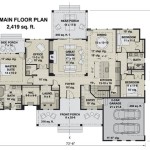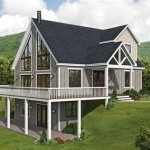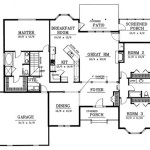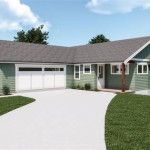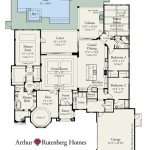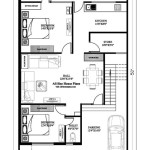The Lasting Appeal of Closed Concept House Floor Plans
Closed concept house floor plans, characterized by distinct and separated rooms, represent a traditional approach to residential design. This layout, contrasting sharply with the increasingly popular open concept, offers a unique set of advantages and disadvantages that continue to resonate with certain homeowners and architectural styles. A comprehension of the features, benefits, and limitations of closed concept designs is crucial for informed decision-making in home construction, renovation, and interior design.
Unlike open floor plans where living spaces flow seamlessly into one another, closed concept designs maintain clear boundaries between rooms. Walls, doors, and corridors define each area, functionally isolating activities and visually creating distinct zones within the home. This approach to space allocation has historical roots and continues to be relevant in specific contexts despite the prevailing trend towards open living.
Enhanced Privacy and Noise Reduction
One of the primary advantages of a closed concept floor plan is the enhanced level of privacy it provides. Walls act as physical barriers, separating activities and conversations from one another. This separation is particularly beneficial in households with multiple occupants, allowing for independent activities without disturbing others. For instance, someone working from home in a closed-off office can maintain focus and avoid distractions from family members in the living room or kitchen.
Furthermore, closed concept designs are effective at noise reduction. Walls dampen sound transmission, reducing the spread of noise throughout the house. This is particularly advantageous in homes with children, musicians, or individuals sensitive to noise. A closed-off kitchen, for example, can contain the noise of cooking and dishwashing, preventing it from disrupting activities in other parts of the house, such as reading or watching television.
The ability to create distinct zones with defined purposes also enhances the sense of privacy. Each room can function as a sanctuary, offering a refuge from the hustle and bustle of daily life. This is particularly appealing for individuals who value personal space and the ability to retreat into a quiet environment.
In contrast to open floor plans, where sounds and activities tend to bleed into all areas, the compartmentalized nature of closed concept designs allows for a greater degree of control over the auditory environment. This control can contribute to a more peaceful and relaxing living experience.
Defined Room Functionality and Aesthetics
Closed concept floor plans excel at defining the functionality of each room. With clearly delineated spaces, each room can be specifically tailored to its intended purpose. A living room remains a space for relaxation and entertainment, a dining room for formal meals, and a study for focused work. This specialization of space contributes to a sense of order and organization within the home.
The distinct boundaries between rooms also allow for greater aesthetic freedom in interior design. Each room can be decorated and furnished in a style that reflects its intended purpose, without the need to maintain a cohesive design throughout the entire living area. This allows for more personalized and expressive design choices, catering to individual tastes and preferences.
For example, a homeowner may choose to decorate a formal dining room with elegant, traditional furnishings, while opting for a more casual and contemporary style in the living room. This level of design flexibility is often more challenging to achieve in an open concept layout, where the interconnectedness of the spaces necessitates a more unified aesthetic.
Furthermore, closed concept designs can be particularly well-suited for displaying art and collectibles. Walls provide ample surface area for hanging artwork and creating visual focal points. The enclosed nature of each room can also enhance the presentation of these items, drawing attention to their individual beauty and significance.
The separation between rooms also means that mess in one area does not necessarily impact the overall appearance of the home. A cluttered kitchen, for example, can be easily concealed from guests in the living room, maintaining a sense of order and tidiness in the more public areas of the house.
Adaptability to Specific Architectural Styles and Climates
Closed concept floor plans are often a natural fit for certain architectural styles, particularly those with historical roots or a focus on formal living. Traditional home styles such as Colonial, Victorian, and Craftsman often feature distinct rooms with clearly defined purposes. These styles typically emphasize formality and structured living, which align well with the compartmentalized nature of closed concept designs.
In colder climates, closed concept floor plans can offer advantages in terms of energy efficiency. By isolating rooms, it is easier to control heating and cooling in specific areas of the house. Unused rooms can be closed off and kept at a lower temperature, reducing energy consumption and lowering utility bills. This targeted temperature control is often more difficult to achieve in open concept layouts, where heat tends to circulate more freely.
Furthermore, closed concept designs can provide greater protection from drafts and temperature fluctuations. Walls and doors act as barriers against cold air infiltration, creating a more comfortable and consistent indoor environment. This is particularly important in regions with harsh winters or extreme weather conditions.
The ability to create distinct zones within the home can also be beneficial in areas with high humidity or insect populations. A closed-off kitchen, for example, can help to contain odors and prevent the spread of pests. Similarly, a closed-off bathroom can help to manage humidity levels and prevent mold growth in other parts of the house.
While open concept designs have gained popularity, closed concept layouts remain a viable and often preferable option for homeowners seeking privacy, functionality, and a specific aesthetic. The enduring appeal of closed concept designs lies in their ability to create distinct, well-defined living spaces that cater to individual needs and preferences.
The choice between an open concept and a closed concept floor plan ultimately depends on individual lifestyle, priorities, and design preferences. While open concept designs offer a sense of spaciousness and connectivity, closed concept designs provide privacy, functionality, and a distinct aesthetic that continues to resonate with many homeowners.
Careful consideration of the advantages and disadvantages of each layout is crucial for making an informed decision that will result in a comfortable and functional living space.
The decision-making process should involve a careful evaluation of the homeowner's lifestyle, family dynamics, and individual preferences.
Seeking guidance from architectural professionals can provide valuable insights and ensure that the chosen floor plan meets the specific needs and requirements of the homeowner.

Traditional Homes With Closed Floor Plans Blog Eplans Com

Traditional Homes With Closed Floor Plans Blog Eplans Com

The Best Closed Floor Plan House Plans

Traditional Homes With Closed Floor Plans Blog Eplans Com

European Style House Plan 4 Beds 3 Baths 2785 Sq Ft 429 6 New Plans Floor

34 Closed Concept Plans Ideas House Floor How To Plan

34 Closed Concept Plans Ideas House Floor How To Plan

Traditional Homes With Closed Floor Plans Blog Eplans Com

Traditional Homes With Closed Floor Plans Blog Eplans Com

Your Open Concept Floor Plan Here S How To Fix It Laurel Home

